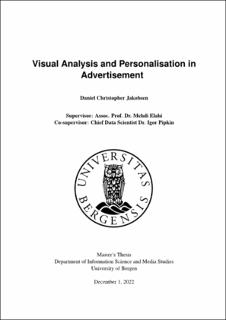| dc.description.abstract | Advertisement is one of the primary sources of revenue for companies. Advertisement can result in increased sales for the companies by promoting their products or by hosting the advertisement of the other companies. While there have been many studies investigating the effectiveness of the advertisement in various domains, there are still challenges to be addressed. Notable challenges are overabundance, privacy, spamming, or irrelevant placement of advertisement. The results of such challenges can be poor quality of advertisement irrelevant to the audience interest or irrelevant in the context of the content in which it has been shown. A colourful and shiny image in an advertisement, promoting a luxury product that is placed together with a news article discussing the growing poverty in certain regions of the world can be an example. This can lead to dissatisfaction of the audience when experiencing a particular irrelevant advertisement. Personalisation techniques can be useful in addressing such challenges. For example it can be used to match the advertisement shown in news outlets to the article. Such techniques can analyse the content of the news articles and find right advertisement that is better suited to the article. However, this requires rich data of displayed advertisement which are not always available. That can be one of the reasons why viewing an irrelevant advertisement is still part of our everyday experience. In this thesis, I have explored the potential of using automatic visual analysis to obtain better representation of the advertisement and to improve the relevance of advertisement to the audience. For such analysis, a number of visual features has been extracted from the images of the advertisements and analysed to better understand their correlations with audience behaviour online when interacting with advertisement campaigns. I have received the data set from Amedia, one of the largest media companies in Norway. The data set includes campaigns and audience behaviour, and the images associated with the campaigns. Four analyses have been conducted in the thesis including, exploratory analysis and correlation analysis. Machine learning models have been built (using CatBoost) based on the audience behaviours and visual features extracted from advertisement. In addition a method called SHAP (SHapley Additive exPlanations) has been used to find explanation of model prediction. The contribution of this thesis includes preprocessing and exploratory analyses of the industry data, a novel data set containing the visual features extracted from the images of the advertisement, a Python prototype, and the results of analyses based on this prototype. | |
